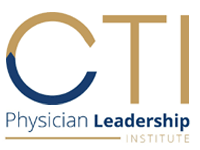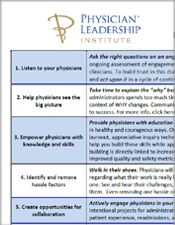Resource:
PLI 7-Step Strategy for Physician Alignment & Engagement
Engage your staff in this 7-step strategy to drive collaboration and improve leadership as well as outcomes across the clinical focus areas.
1. Listen to your physicians
Ask the right questions on an ongoing basis, and listen to understand. Thoughtful questions are crucial tools for ongoing assessment of engagement. Questions must be asked with physicians in mind as people, not just clinicians. To build trust in this dialogue, you must intend to give physicians a voice, listen to what is being said, and act upon it in a cycle of continuous improvement. Know their top concerns!
2. Help physicians see the big picture
Take time to explain the “why” behind initiatives, and describe what success looks like. The majority of the time, administrators spends too much time speaking to physicians about WHAT to change and not enough time providing the context of WHY changes. Communicating the idea simply and clearly, like Dr. Martin Luther King’s messaging, is critical to success. For more info, click here to read our work on the FOUR STEPS TO GREAT LEADERSHIP COMMUNICATION.
3. Empower physicians with knowledge and skills
Provide physicians with education in how to lead. Physicians need skill-building in how to address change and conflict in healthy and courageous ways. Other essential development includes strategies for identifying and preventing burnout, appreciative inquiry techniques, adaptability to change, and resilience. The Physician Leadership Institute can help you build these skills while applying the learning to real-world challenges. This experience and reciprocal trust-building is directly linked to increased physician satisfaction and engagement, improved organizational alignment, and improved quality and safety metrics.
4. Identify and remove hassle factors
Walk in their shoes. Physicians will bristle at what they perceive to be a lack of understanding by administrators regarding what their work is really like. Walk alongside your physicians. Round with them. Sit and talk to them, one on one. See and hear their challenges, firsthand. Have them identify their hassles and create plans to remove or neutralize them. Even removing one hassle or obstacle will build trust and goodwill. You can’t afford to not do this.
5. Create opportunities for collaboration
Actively engage physicians in your organizational strategy! Collaboration is a muscle that must be exercised. Create intentional projects for administrators and physicians to work on together. Ask physicians to lead in areas like the patient experience, readmissions, and reduction of outcome variations.
6. Develop physicians as Change Agents for peer communication and influence
Trust physicians to lead, and empower them to do so daily as your organization’s primary agents of change. In an expert culture, physicians value peer communication and accountability. Developing physician leaders from those in the trenches improves engagement and trust building. PLI trains and certifies physician change agents that Lead with Purpose, Lead with Strategy, Lead Others through Influence, Lead Self, and Lead for Results.
7. Coach your physician leaders for success
Providing coaching to support your physician leaders. Leadership is not taught in medical education and residency, and supporting your physician leaders through coaching is a proven strategy. Coaches increase physician self-awareness, effectiveness, and bridge the gap between ideas and execution to deliver results. PLI has an elite group of coaching professionals and a suite of evidence-based tools to serve in this capacity.

